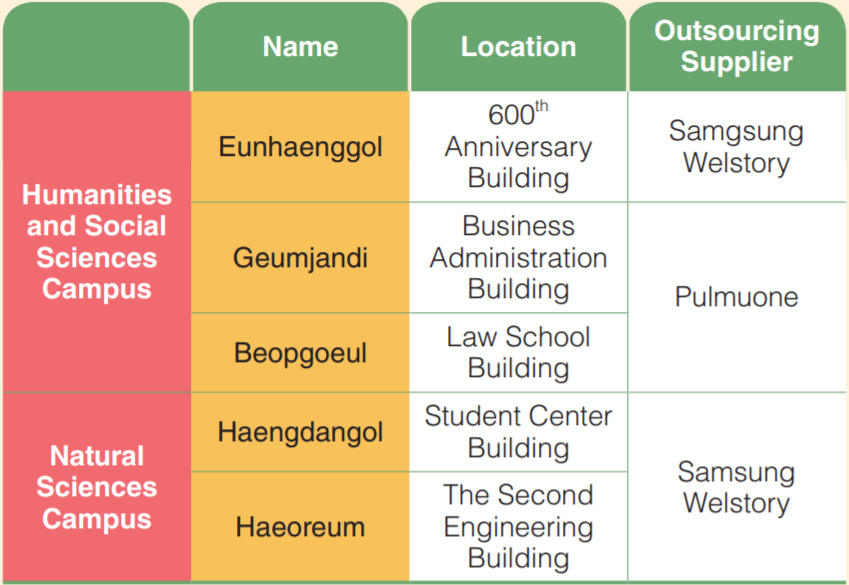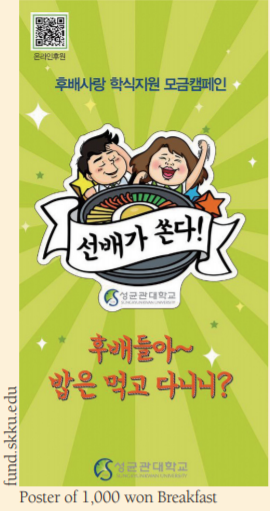School cafeterias are essential places where Kingos can eat delicious meals, which is one of the most important parts of student welfare. Many Kingos, however, are reluctant to eat in the school cafeterias and eat off-campus instead, which obscures the purpose of the school cafeterias. For those Kingos, the Sungkyun Times (SKT) introduces the school cafeterias’ current situation, the problems, and suggests several possible solutions.
The Current Situation of the School Cafeterias
There are five school cafeterias at Sungkyunkwan University (SKKU), three are at the Humanities and Social Sciences Campus, and the other two are at the Natural Sciences Campus.

The Geumjandi Cafeteria is a representative cafeteria at the Humanities and Social Sciences Campus, which is located in the center of the school and is used by many Kingos and visitors. It had been first renovated in 2013 and was recently remodeled in 2018, so it is a clean and pleasant facility. Geumjandi cafeteria is run by Pulmuone and includes many types of restaurants such as CocoTokyo (Japanese restaurant), and Ttuksim and Myeongnyunsoban (Korean restaurant). After the first remodeling, various menus were added, but the price also increased greatly. Currently, the menu with the lowest price, except for instant noodles, is 3,500 won. Since 2018, the cafeteria has introduced a special menu system called Myeongnyunsoban, which offers a finer and more expensive set menu such as tandoori chicken and chicken breast chop steak at around 5,500- 6,000 won. The foods of Myeongnyunsoban are at a similar price range to off-campus dining. Haengdanggol cafeteria in Natural Sciences Campus is clean and has the largest cafeteria in the school. Samsung Welstory runs it, which currently operates three cafeterias at SKKU. According to Park Eun-yeong, Welstory’s nutritionist at Eunhaenggol, the menu is decided by considering recommended menus of both Samsung Welstory and SKKU. Welstory’s cafeteria includes Japanese, Chinese and Italian restaurants. Here, the lowest price menu consists of 3,500 won.

Problems Regarding the School Cafeteria
According to a survey of 150 Kingos regarding the school cafeteria, the frequency of students eating at the cafeteria is very low. The number of those who answered that they never use school cafeterias and who use them once or twice a week was 118, which was 78% of the surveyed students. Regarding the overall satisfaction of the cafeterias, 43% of respondents are not satisfied with the school cafeteria.

Positive Directions of SKKU Cafeterias
1,000 Won Breakfast
A fund-raising campaign to support breakfast meals for Kingos has been practiced among the SKKU alumni, since July 2017. Thanks to the support, students have been able to eat breakfast for 1,000 won at four cafeterias, including Eunhaenggol, Geumjandi, Haengdangol, and Haeoreum since the second semester of 2017. The donation relieved the budget burden on students so that the number of Kingos who eat breakfast increased a lot. According to the Development Cooperation Team of SKKU, there are only about 280 Kingos who ate breakfast in the first semester of 2017 before the campaign. After the campaign, however, about 406 students have breakfast regularly. Recently, the total sum of the contributions from 2017 to 2018 was 145.68 million won. The united efforts of the alumni exert positive influence on Kingos, which Kingos are proud of.

Various Options and Menu Enhancement
Since the school cafeterias are outsourced, reforming the cafeteria menus can be difficult. Nevertheless, the school should keep trying to improve the cafeteria menus by making a special menu like Myeongnyunsoban. Also, in order to increase the diversity of foods, Eunhaenggol cafeteria continues to offer a variety of menus from around the world through the “International Food Day” program, which takes place every Wednesday. Eunhaenggol is planning to introduce foods that are not easily seen in school cafeterias like Russian beef stroganov.
Moreover, the cafeterias should provide fixed and signature menus that are healthy and cheap rather than instant noodles. In the case of HUFS, they have various menu choices, like a variety of pork cutlets, and fixed menu items, such as crunchy Korean fried chicken and toast. Therefore, students will have pleasure in choosing the menu.
Cafeteria for Multicultural Students
If constructing a new vegetarian cafeteria is not possible, adding one or two menu items for vegetarians and multicultural students at every meal could be an alternative. Sejong University conducts a program called “Monday without Meat” and provides a vegetarian diet every Monday. Likewise, SKKU should introduce the vegetarian diet step by step. Introducing ingredient labeling may be another good way to consider various Kingos. With ingredient labeling, vegetarians, students with allergies, and those whose diet is limited due to certain religions will not have to ask the cook for ingredient information every time they have a meal.
When Kingos look back on their university life in the future, the memories of having a nice meal with their friends might be an important part of it. It would be much more valuable if the memories are made in the school cafeteria instead of in off-campus restaurants. Currently, SKKU’s cafeterias have a high possibility of enhancement with sufficient infrastructure and hard-working cooks and nutritionists. SKT looks forward to tasting a variety of great menus in the cafeteria.
